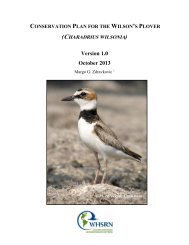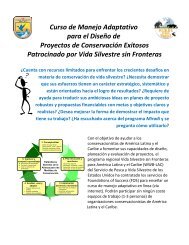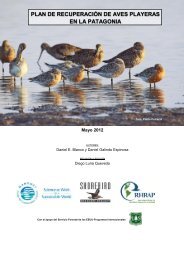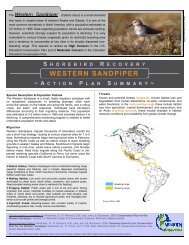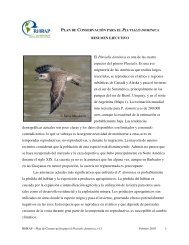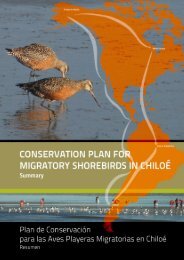Sanderling Plan - Western Hemisphere Shorebird Reserve Network
Sanderling Plan - Western Hemisphere Shorebird Reserve Network
Sanderling Plan - Western Hemisphere Shorebird Reserve Network
You also want an ePaper? Increase the reach of your titles
YUMPU automatically turns print PDFs into web optimized ePapers that Google loves.
However, <strong>Sanderling</strong>s are an excellent “umbrella species” for coastally dependent<br />
species. They have declining populations, are sensitive to factors that limit many other species<br />
(e.g., human disturbance, pollution) (Piersma and Lindstrom 2004), are responsive to<br />
management that removes limiting factors, and are relatively easy to identify and monitor<br />
(Granfors and Niemuth 2005). With directed efforts, the conservation of <strong>Sanderling</strong> habitats<br />
would benefit many other coastal species as well, such as in South America, where the<br />
<strong>Sanderling</strong> is the most abundant shorebird for >3,000 kilometers of Pacific coastline (from Peru<br />
southwards; Morrison and Ross 1989.<br />
CONSERVATION OF IMPORTANT HABITATS<br />
Ensuring that this species has adequate habitat in which to feed and rest during the<br />
nonbreeding season (i.e., the time of year when it overlaps with humans) will require a concerted<br />
effort at many sites. Fortunately, a number of conservation efforts already target or include<br />
shorebirds (including the <strong>Sanderling</strong>) in their habitat protection or management plans, such as the<br />
Ramsar Convention, <strong>Western</strong> <strong>Hemisphere</strong> <strong>Shorebird</strong> <strong>Reserve</strong> <strong>Network</strong> (WHSRN), North<br />
American Waterfowl Management <strong>Plan</strong> (NAWMP) Joint Ventures, Ducks Unlimited, Canadian<br />
<strong>Shorebird</strong> Conservation <strong>Plan</strong> (regional and national plans), U.S. <strong>Shorebird</strong> Conservation <strong>Plan</strong><br />
(regional and national plans), Mexican <strong>Shorebird</strong> Conservation Strategy, numerous federal and<br />
state agencies, and nongovernmental organizations (i.e., The Nature Conservancy, and others).<br />
These conservation and management strategies identify important conservation issues and areas<br />
of great conservation value. Implementation of these conservation actions, however, remains a<br />
challenge. Additional effort is needed to identify barriers to, and opportunities for, protecting<br />
important migration and wintering sites for the <strong>Sanderling</strong>. Because <strong>Sanderling</strong>s use open beach<br />
habitats, and these areas are of considerable recreational and commercial importance to humans<br />
as well, the need for a careful and targeted strategy is important. Several important components<br />
in developing such a strategy include conducting a review of efforts expended to protect coastal<br />
sites, including the barriers encountered and (especially) those case studies with successful<br />
outcomes; and approaching conservation/management solutions from a ‘common ground’<br />
viewpoint through investment in innovative/creative solutions, and using outreach and education<br />
more effectively. A shift in perspectives is necessary to loosen deadlocks (where they occur) and<br />
to develop effective, long-term approaches.<br />
WHSRN – <strong>Sanderling</strong> Conservation <strong>Plan</strong>, February 2010, v1.1 47





